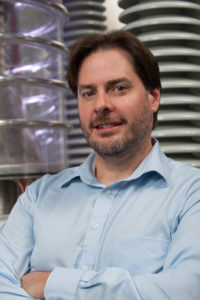In addition to creating a company that may soon supply two-thirds of the global demand for radioisotopes used in medical imaging, Wisconsin’s Greg Piefer is moving towards plans to create machinery that will produce clean energy and solve nuclear waste issues.
At the present time, though, the founder and CEO of Janesville-based SHINE Medical Technologies is leading his company through the construction of a facility in Janesville and eventual facility in Europe.
SHINE’s Janesville facility, expected to be completed in 2021 with commercial-scale isotope production starting in 2022, is for the commercial production of molybdenum-99, or Mo-99, which decays into technetium‑99m used in more than 40 million medical imaging procedures around the globe each year.
Piefer is also the founder and former president of Morona-based Phoenix Nuclear Labs, a sister company to SHINE that makes Piefer’s neutron generator design.
This past fall, the company announced plans to build a similar facility on a yet-to-be-determined site in Europe. When the European facility begins production, SHINE will be capable of producing more than two-thirds of the global patient demand for Mo-99. Europe is the second biggest market in the world for using the Mo-99 isotope at roughly 10 million tests per year, said Piefer, who holds multiple degrees from the University of Wisconsin-Madison.

Europe’s radioisotope supply is robust, but if the region were to lose one reactor, “that supply chain becomes unsustainable and unreliable,” Piefer said. A high flux reactor in the Netherlands that’s owned by the European Commission is expected to be decommissioned in 2025, Piefer added.
In September of 2019, SHINE announced it hired Harrie Buurlage, a former executive at a nuclear service provider in the Netherlands, as vice president of European operations to oversee all of the company’s activities in Europe, including the company’s siting, construction and operation of a medical isotope production facility there.
For the facility in Europe, SHINE will likely have to modify the design of its U.S. facility design to meet European codes, Piefer said. Given the long process to build a nuclear facility, SHINE is starting the process now to begin construction in 2023 and open in 2025, he said. The Europe project could be financed with debt funding or equity funding, and with SHINE projected to generate revenue from its U.S. plant before construction would begin, the cost will be much less, Piefer said.
In October, the company secured $50 million from Los Angeles investment firm Oaktree Capital Management to fund the construction of its U.S. isotope production facility, bringing its total capital raised to more than $200 million.
SHINE is also working to commercialize Lu-177, a therapeutic isotope currently used to treat neuroendocrine cancers.
Piefer created Phoenix in 2005 with a long-term goal of achieving clean, fusion energy. SHINE Medical was phase two of that plan. The third and fourth phase of his plan—mitigating the effects of nuclear waste to make it benign, and clean energy generation with fusion power—are in the queue.
Both the third and fourth phase could be spun into separate companies. There’s also the option to pursue both under the SHINE umbrella, which is more equipped to produce what Piefer has in mind, rather than launching a new company.
“It could be more lucrative to start a new company, but this is about legacy,” he said.

Recent Comments